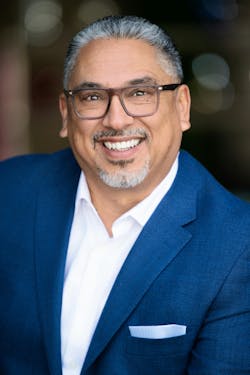How To Bridge the Generational Gap Between New and Veteran AMTs and A&Ps
“Today, most aircraft mechanics are over 40 years old, with the percentage between 18 and 30 in the single digits,” according to experts at Oliver Wyman. In the next year, Oliver Wyman predicts that the discrepancy in supply and demand for aircraft mechanics could reach between 8% and 12%.
Alfredo Garcia, director of Sales and Business Development at ACI Jet, gave expert insight into this issue during his educational session entitled “Seasoned Technicians: Bridging the Generational Gap in Aviation” at the 2025 NBAA Maintenance Conference in Columbus, OH.
Throughout the session, Garcia prioritized creating a dialogue over giving a monologue and made a point to engage with audience members in maintenance roles from all demographics.
Garcia said, “We often talk about the generational divide, but I think what we're really facing is a perspective gap. Veterans are fast, accurate and do things under pressure. New technicians are curious, digital and still learning how to navigate real world expectations.”
“That disconnect isn't about attitude, it's about context. For example, a veteran may view a mis-torqued stick as carelessness, while a young technician might see it as a gap in the system for feedback and double checking. Same moment, two completely different perspectives,” Garcia continued.
He added, “This isn’t just a technical issue. It’s about culture. It’s about emotion. It’s about leadership and how we move forward together.”
What Is the Generational Gap?
To highlight the rich potential within the aviation maintenance workforce, Garcia explored each of the demographics typically present in a repair shop.
He noted, “We've got up to four generations working side by side in the same hangers. We have Baby Boomers who walk into these jobs and carry deep tribal knowledge, and they are retiring. We have Gen X, pragmatic, independent, often juggling leadership with hands-on work. We have the Millennials, tech savvy, collaborative, looking for purpose. And we have the Gen Z, fast learners, highly adaptable, but still figuring out workplace dynamics.”
“That's diversity in its richest form, like any strong team, each generation brings something unique to the table, but they also bring differences in communication, expectation and priorities,” Garcia added.
Garcia stressed the importance of working with each other rather than against each other in times where these generational differences arise.
He advised, “This work isn't about a generational handoff. It's about creating a generational handshake. Legacy isn't what you leave behind, it's who you bring with you.”
Examples of Cross-Generational Communication
To illustrate the value each demographic can bring to the other, Garcia shared anecdotes about his experiences with professionals in aviation maintenance of varying ages and experience levels.
He spoke about Tony, a veteran mechanic who encountered challenges training new, young technicians.
Garcia explained, “A young tech asked for help torquing a component. Tony showed him how to do it, walked away, and a few minutes later, found the final component improperly torqued. That’s when I thought, maybe it's easier, I just do it myself, Tony said.”
He continued, “But what made Tony different was this: even though he was frustrated, he still cared. He wanted to teach. He wanted to make a difference, he just didn't know where to start or if anyone was ever even listening.”
Garcia also shared a story about an interaction he had with a younger technician while working as a general manager. The story involved the younger technician completing a task incorrectly and Garcia stepping in to correct him.
Garcia said, “I started yelling at him. Telling him, hey, get the F out of the way. This how you do it. And this young man was 24 years old, and he looks at me with tears building up in his eyes, and he says, Alfredo, don't talk to me like that, I'm a man. Please treat me with respect. I stood back. My eyes started tearing up because I was embarrassed, because I was treating him the way they would treat me when I was a kid. And right there I felt that that was the wrong way to teach and to mentor.”
How To Embrace Reverse Mentorship
In response to his own story, Garcia introduced the concept of reverse mentoring, wherein a younger employee mentors an employee who’s older than they are. Garcia explained how he engages in reverse mentorship in his own work.
He said, “At work, I have a 28-year-old young man that works for me. I’ve asked him to mentor me as well…Believe it or not, he keeps me in line. He teaches me. He taught me Google Docs—I didn’t know Google docs. He taught me how to be more efficient in my time. He taught me about work-life balance. So, I encourage everyone to do the reverse mentoring. It’s pretty rewarding.”
Garcia also told another story about a veteran mechanic named Eddie.
He shared, ““Then there's Eddie. After I told him Tony's story, he decided to try something new. He hired a fresh-out-of-school technician and made a conscious decision to mentor him. But also, he let himself be mentored. Eddie didn't use social media. He didn’t know the latest trends or slang, but his tech did, and instead of resisting it, he said, Why not let him teach me too? That changed everything.”
Garcia continued, “The tech grew fast. Eddie grew sharper. He discovered tools, ideas and workarounds he wouldn't have explored otherwise. They developed mutual respect, where the seasoned mind met fresh eyes. Their working dynamic became more like a partnership than a hierarchy. Eddie told me, this kid reminded me why I got into aviation in the first place.”
“Now, Eddie is a full-on advocate for reverse mentorship, not just as a leadership strategy, but as a survival tactic for staying relevant and energized. He encourages other veterans to embrace it, not as a compromise, but as a powerful way to evolve. Reverse mentorship isn't a gimmick, it's a growth strategy. It's how Eddie stayed sharp, and it's how we all stay relevant,” Garcia concluded.
How To Address the Generational Gap in the Aviation Maintenance Workforce
When considering actionable steps that parties can take, Garcia gave a few examples, “Join your local aviation association. Create DOM and aviation manager roundtables—which we're starting in Scottsdale, Arizona. Build formal and informal mentorship opportunities. Invite people who look and think differently than you. Make time for conversation, not just procedures.”
He added, “I believe we can close the gap and build something stronger by making three commitments. Number one: listen. Number two is to share the workload. Number three is to redefine leadership.”
Garcia provided more detail, “Listen. Start by asking, what's challenging right now? When we make space to listen, not to solve, we learn what each person values, fears and needs. Culture begins with curiosity.”
“Share of the workload. Mentoring doesn't mean slowing down, it means building up. I knew a chief inspector who began training his much younger employee by assigning small records research tasks. It took time, but by the second month, the team was more efficient, and the boss wasn't working weekends anymore and spending more time at home with his family,” Garcia stated.
He continued, “Sharing the workload also means letting younger techs try and fail without shame. It means mentoring in real time, not perfectionism. You're not just teaching tasks. You're shaping thinking. That's how legacy gets built.”
On his third piece of advice, redefining leadership, Garcia said, “Leadership today isn't about being the loudest or most senior voice, it's about making space for others to grow. You can do that by building mixed generation teams, recognizing different contributions, creating psychological safety for questions and curiosity. A great leader doesn't just fix planes, they grow people.”
Garcia also addressed mechanics directly, saying, “To the veterans: We see you. We honor your gift and endurance. You’re not invisible, you’re essential. To the younger generation: We need you to step in, to ask questions, to teach us new things, to carry the industry forward.”
He added, “Let's stop waiting for the gap to close on its own. Let's build a bridge together…Take one action. Start one conversation. Build one bridge. Because when generations move together, we all go further.”


